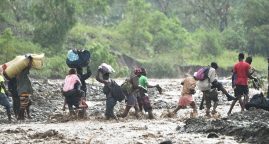New UN-backed report cites climate change among factors fuelling internal displacement
Disasters associated with slow processes of environmental change – drought, sea level rise and desertification – demonstrate again the growing importance of climate change as a driver of disaster risk, as senior United Nations official said today on the heels of the release of a global report which revealed that more than 19 million people in 2015 were forced from their homes by natural hazards.
“Internal displacement is a reliable barometer of the scale of humanitarian needs around the globe and last year there were 27.8 million displacements associated with conflict, violence and disasters in 127 countries including 19.2 million forced by natural hazards,” said the head of the UN Office for Disaster Risk Reduction, Robert Glasser, today citing new figures in the Global Report on Internal Displacement.
Mr. Glasser said underscored that the figure goes to the heart of the humanitarian crisis now facing the world and which will be discussed at the World Humanitarian Summit, to be convened by UN Secretary-General Ban Ki-moon 10 days from now.
“The majority of displacement caused by natural hazards was caused by extreme weather events during a year which saw a record number of droughts, widespread flooding and 90 major tropical storms,” he continued, noting that much of this was fuelled by a very strong El Niño occurring in the context of increasing climate change.
Weather-related hazards resulted in 14.7 million displacements, Mr. Glasser added, saying that the Internal Displacement Monitoring Centre is to be congratulated for attempting to capture this important data.
“Our concern must be to develop better capacity to manage disaster risk at local level to avoid displacement on this scale and that means improving early warnings, providing low cost housing in safe locations and doing all we can to reduce the numbers of people affected by disasters as agreed by UN Member States when they adopted the Sendai Framework for Disaster Risk Reduction last year,” he underscored.
The Sendai Framework for Disaster Risk Reduction is the global plan for reducing disaster risk and disaster losses adopted by UN Member States at a World Conference in Sendai, Japan, last year. It sets targets for reducing disaster related mortality, numbers of people affected, damage to critical infrastructure and economic losses.
- Read the Global Report on Internal Displacement was produced by the Norwegian Refugee Council.
- Read the article on UN website
Related Articles
Unity within Security Council vital to prevent mass atrocities – UN chief Guterres
04/18/2017. “We must collectively draw strength from the letter and spirit of the Charter to better prevent armed conflict and sustain peace through development [by] ensuring effective protection of all human rights – civil, political, economic, social and cultural,”
Where do we go from here? 1st Annual Grand Bargain Meeting
06/20/2017. “Together we were determined to reset our ways of working and refocus our efforts on achieving humanitarian gains” Peter Maurer.
Haiti: Malteser International prepares emergency relief after Hurricane Matthew
10/05/2016. Staff on the ground mobilize aid to help people affected by severe flooding.






